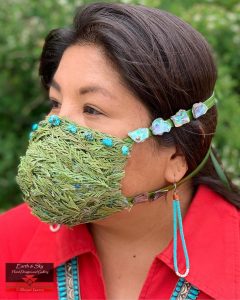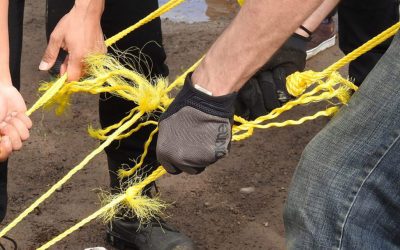Breathe. Collective: Traditional Artists on Pandemic Masks
Photo by Veridian Photography. Mask by Celina Loyer.
By Connie Kulhavy
For many Indigenous people in North America, the COVID-19 pandemic has carried echoes of a not-so-distant past. “It had not been many generations prior that infectious diseases had greatly impacted First Nations, Métis and Inuit peoples,” said Métis artists Nathalie Bertin and Lisa Shepherd.
Bertin and Shepherd both center Métis beadwork in their artistic practices. Métis Flower Beadwork has a signature style and a long history. The iconic five-petal flower, known as the prairie rose, which honors the matriarchs, has been used in many of the designs for at least 200 years and is the most popular of flowers. Branches of vines throughout the designs are called mouse tracks. Some say the beaded colours on the sides of the vines were colours that indicated affiliations to different families and communities. Horse hair was colored and could be used as a trim in the smoked and tan moccasins. Many of these traditions still endure today.
Yet, in March 2020, the artists observed a lack of beaded objects being made by artisans. “In speaking with peers, it seemed the pandemic had completely blocked them of their ability to create.”
Through the realization that all people all over the world were affected by the pandemic, the decision was made to open up the group to anyone who wanted to create a mask in any traditional medium that is authentic to their culture and artistic practice.
Social media platforms became a lifeline to many for staying in touch with friends, family and coworkers in the midst of quarantine and lockdown measures. Artists Bertin and Shepherd took to Facebook and create a group where people could share hand-crafted masks inspired by the pandemic. They called this platform Breathe: A collection of traditionally crafted masks demonstrating resiliency through the 21st century pandemic.
As a result, there are hundreds of masks featured in the public group in a wide variety of styles. Because the pandemic affects so many people on a personal level, many of the artists who share their hand-crafted masks also include stories: about the materials used, the inspiration behind the masks, and their hopes about the future.
The online group is the fascinating outcome of traditional knowledge marrying contemporary events and technology, with techniques passed down through generations to create face masks — an object that has become an emblem for the coronavirus pandemic in 2020.
The Breathe. Collective has been featured in a documentary from the CBC. Some of the masks featured on Facebook have been purchased by museums, and others will tour in a forthcoming exhibition.
The following is a selection of the masks from the Facebook group, courtesy of the artists featured.
Connie Kulhavy is a Métis artist and a cultural facilitator in Edmonton, Alberta, and surrounding School Districts, and a facilitator for Teacher Professional Development self-care days. Connie’s Flower Beadwork has sold through the Nanaimo Art Gallery and The Royal Alberta Museum, and will be showcased in the Sherwood Park Museum in the Spring of 2020.







